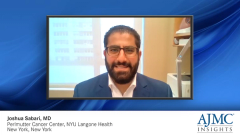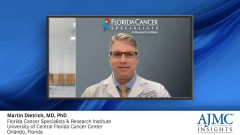
Challenges With KRAS G12C Mutations
Dr Sabari highlights typical outcomes for patients with NSCLC vs KRAS G12C-mutated NSCLC, as well as challenges associated with targeted treatments.
Episodes in this series

Joshua Sabari, MD: KRAS G12C mutations are occurring in about 10%–14% of the patient population. Prior to 2018–2019, any strategy that we've looked at inhibiting RAF, RAS, ERK downstream using MEK inhibition, even going upstream in the MAP kinase pathway, we've had very little success in this setting. More recently, with the approval of sotorasib, a KRAS G12C specific inhibitor, these are covalent inhibitors to the cysteine residue on KRAS, and we've been able to improve response rates to the mid-upper 30%, low 40% range across the board. This is nowhere near where we are in the EGFR space. In the EGFR space, we're seeing response rates in the 80% range median progression-free survival in the 19–20-month range. Unfortunately, in the KRAS space, we're in the early days. With sotorasib, median progression-free survival is now down to 6.3 months, and overall survival median is 12.5 months, 3-fold that with EGFR mutant lung cancer. We need to do better. There are other agents in the KRAS G12C space, such as adagrasib or MRTX 849, that are currently being developed. We see similar response rates to sotorasib in that 40% range, and we don't have publicly available median progression-free or overall survival data to date. We need to do more for this patient population in this space because we're not where we are in the EGFR or outpatient population yet.
One of the key problems with identifying and acting upon an alteration is waiting for that result, right? Oftentimes, we request the correct test, but because patients are symptomatic, we jump the gun and start therapy based on inconclusive or not fully complete information for our patients. I'll give you an example. You could have a patient who is a heavy smoker who comes into your clinic and has an X generation sequencing sent. The report is not back yet, but you do get their PD-L1 expression back quickly. Lo and behold, they have a PD-L1 expression of 100%. In the community, the oncologist will jump the gun here and start pembrolizumab or a PD-1 or PD-L1 inhibitor in this setting. Three or 4 weeks later, your tissue NGS [next generation sequencing] comes back, and the patient has a MET exon 14 skip alteration, for example, or a BRAF V600E mutation. We know that there are matched FDA-approved therapies that will work better in that patient population than potentially single-agent PD-1 or PD-L1 inhibitor. There's a huge lack of education, both in the academic and in the community setting, on understanding what driver alterations patients should be matched to what therapies. There are many therapies that have been approved in the last 3 or 4 years, and it's tough to keep up with the literature for a community oncologist. It’s critical to understand what drivers you're looking for and what the best matched targeted therapy is for that specific patient. Interestingly, with different driver alterations, you might have 3 or 4 medications that are FDA approved and some upwards of 6 or7. [It’s important to understand] what therapy has the best data, best response rate, median progression-free survival, overall survival before selecting a therapeutic for our patients [that will have the best safety profile].
Outside of KRAS G12C and EGFR exon 20 insertion mutations, all targeted alterations we mentioned have matched FDA-approved therapies in the frontline setting. If it was missed and patients are started on some other therapy, either chemotherapy and immunotherapy or immunotherapy alone—there's always caution about the immune-related adverse events that may occur after starting immunotherapy followed by a small molecule tyrosine kinase inhibitor—it's OK to utilize the information that you then have in the second-line setting. With KRAS G12C, which sotorasib is approved in the second-line setting, most patients are having progression on chemotherapy and immunotherapy or immunotherapy alone. You may not have done NGS in the frontline setting, and you may miss out on that patient population. Interestingly, KRAS G12C patients, 98% are heavy or former smokers. This is a patient population that oftentimes may be missed up front, where you didn't have that high pretest probability of identifying an actionable driver alteration such as EGFR and ALK. It's important [to obtain NGS data in the second-line setting if you did not have it already]. It's OK to get the information in the second-line setting; you can still act upon that information. It's great to have that information up front so you can plan your next regimens that are going to be available for this patient.
This transcript has been edited for clarity.
Newsletter
Stay ahead of policy, cost, and value—subscribe to AJMC for expert insights at the intersection of clinical care and health economics.
































































